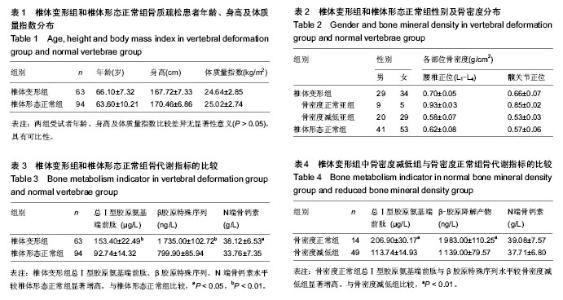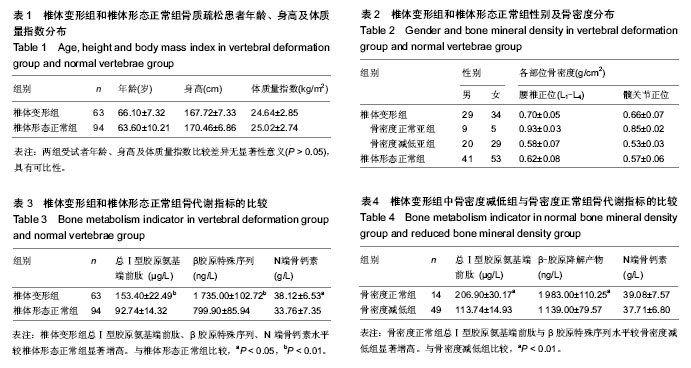| [1] Kwok AW, Gong JS, Wang YX,et al.Prevalence and risk factors of radiographic vertebral fractures in elderly Chinese men and women: results of Mr.OS (Hong Kong) and Ms. OS (Hong Kong) studies. Osteoporos Int. 2013;24(3):877-885.
[2] 卢春燕,张林,徐粱,等.一家大型医院住院患者骨质疏松症诊治现状的初步调查[J].中华骨质疏松和骨矿盐疾病杂志,2010,3(1): 43-48.
[3] 祝坤,刘忠厚.骨质疏松危险因素与骨折治疗[J].中国骨质疏松杂志,2000,6(4):81.
[4] Cooper C, Atkinson EJ, Jacobsen SJ, et al. Population-based study of survival after osteoporotic fractures.Am J Epidemiol. 1993;137:1001-1005.
[5] National Osteoporosis Foundation. Physician guide to prevention and treatment of osteoporosis. Washington, DC: National 0steoporosis Foundation. 2003.
[6] Klotzbuecher CM, Ross PD, Landsman PB, et al. Patients with prior fractures have an increased risk of future fractures: a summary of the literature and statistical synthesis. J Bone Miner Res. 2000;15(4):721-739.
[7] Gallagher JC, Genant HK, Crans GG, et al. Teriparatide reduces the fracture risk associated with increasing number and severity of osteoporotic fractures. J C1in Endocrinol Metab. 2005;90(3): 1583-1587.
[8] Lindsay R, Silverman SL, Cooper C, et al. Risk of new vertebral fracture in the year following a fracture. JAMA. 2001;285(3):320-323.
[9] Kado DM, Browner WS, Palermo L, et al. Vertebral fractures and mortality in older women: a prospective study. Study of Osteoporotic Fractures Research Group. Arch Intern Med. 1999;159(11):1215-1220.
[10] Gehlbach SH, Bigelow C, Heimisdottir M, et al. Recognition of vertebral fracture in a clinical setting. Osteoporos. 2000;ll(7): 577-582.
[11] Delmas PD, van de Langerijt L, Watts NB, et al. Underdiagnosis of vertebral fractures is a worldwide problem: the IMPACT study. Jbone Mi ner Res. 2005;20(4):557-563.
[12] 黄际远,宋文忠.双能X射线骨密度测定在骨质疏松诊治中的应用[J].实用医院临床杂志,2008,5(5):127-128
[13] Sugitanil I, Fujimoto Y. Effect of postoperative thyrotropin suppressive therapy on bone mineral density in patients with papillary thyroid carcinoma: A prospective controlled study. Surgery.2011;50(6):1250-1257.
[14] Nakamura T.Bone and Calcium Update Diagnosisand therapy of metaboiic bone disease update.Advances in clinical trials for osteoporosis in Japan.Clin Calcium.2011;1(12): 1895-1901.
[15] World Health Organization.Guidelines for Preclinical Evaluation and C1inical trials In Osteoporosis.Geneva. 1998,
[16] 潘莉莉,佟威威,卢丽萍,等.中老年人骨密度骨代谢相关因素探讨[J].中国老年学杂志,2006,26(10):1349-1351.
[17] 黄晓丽,郑玉霞,曹立,等.老年性骨质疏松患者骨代谢指标的观察[J].现代预防医学,2007,34(24):4652-4653.
[18] 李平生,韦兴,殷亚昕,等.骨质疏松症骨代谢生化指标与骨密度测量分析[J].中国骨质疏松杂志,2002,11(1):22-4.
[19] 李恩,薛延,王洪复,等.骨质疏松鉴别诊断与治疗.北京:人民卫生出版社, 2005.
[20] Genant HK, Wu CY, van Kuijk C, et al. Vertebral fracture assessment using a semiquantitative technique. J Bone Miner Res.1993, 8(9):1137-1148.
[21] 刘欣,王全平,柏树令,等.骨质疏松腰椎椎体形态变化规律的影像学研究[J].中国医科大学学报,2005,6(34):529-530
[22] Kadowaki E, Tamaki J, Iki M, et al. Prevalent vertebral deformity independently increases incident vertebral fracture risk in middle-aged and elderly Japanese women: the Japanese Population-based Osteoporosis (JPOS) Cohort Study. Osteoporos Int. 2010;21(9):1513-1522.
[23] Roshandel D, Thomson W, Pye SR, et al.Polymorphisms in Genes involved in the NF-kappaB signalling athway are associated with Bone Mineral Density Geometry and Turnover in Men. PLoS One. 2011;6(11):e28031.
[24] Jacobs-Kosmin D, Sandorfi N, Murray H, et al.Vertebral deformities identified by vertebral fracture assessment: associations with clinical characteristics and bone mineral density. J Clin Densitom. 2005;8(3):267-272.
[25] 熊恩富,王维,熊琳,等.骨质疏松患者的骨密度与骨代谢改变[J].中国临床康复,2006,10(36):154-155.
[26] 俞华威,王兆杰,胡小军,等.抗骨质疏松药物应用的依据:骨生化代谢标志物及骨组织病理学[J].中国组织工程研究,2013, 17(28): 5126-5132
[27] 郭慧峰,张省亮,潘锋丰,等.骨代谢标志物与老年骨质疏松症的相关性[J].中国医药导刊,2011,13(10):1710-1712.
[28] Greenspan SL, von Stetten E, Emond SK, et al. Instant vertebral assessment: a noninvasive dual X-ray absorptiometry technique to avoid misclassification and clinical mismanagement of osteoporosis. J C1in Densitom. 2001;4(4):373-380.
[29] Sornay-Rendu E, Munoz F, Garnero P, et al. Identification of osteopenic women at high risk of fracture:the OFELY study.J Bone Miner Res. 2005;20(10):1813-1819.
[30] Wainwright SA, Marshall LM, EnsrudKE, et al. Hip fracture in women without osteoporosis. J Clin Endocrinol Metab. 2005;90(5):2787-2793.
[31] 范宏斌,王全平,马真胜,等.骨密度变化与腰段脊柱退行性变[J].第四军医大学学报,2000,21(1):52-55.
[32] 程晓光,屈辉, Harry K,等.骨质疏松椎体骨折的评价[J].中国骨质疏松杂志,2002,8(1):87-89
[33] 肖恩,孟萍.骨质疏松骨代谢生化指标的研究进展[J].中国骨质疏松杂志,2008,14(3):212-216
[34] Ishibashi H.Evaluation methods of therapeutic effects of drugs for osteoporosis.Clin Calcium.2012;22(6):890-895.
[35] 许爱萍.骨代谢标志物与绝经后妇女骨质疏松症的相关性研究[J].检验医学与临床,2009,12(6):2109-2110.
[36] 欧萌萌,黄建荣.绝经后妇女骨质疏松症患者血清β-Crosslaps、PINP和N-MID检测的评价[J].标记免疫分析与临床,2011,18(4): 238-240.
[37] 刘莉莉,张忠英,陈亮,等.血清β一胶原降解产物及骨钙素联合检测评价骨转换的意义[J].中国组织工程与临床康复,2007,11(2): 268-270.
[38] Bruyere O, Collette J, Delmas P, et al.Interest of biochemical markers of bone turnover for long-term prediction of new vertebral fracture in postmenopausal osteoporotic women. Maturitas. 2003;44(4):259-265.
[39] Ross PD, Davis JW, Epstein RS, et al.Pre—existing fractures and bone mass predict vertebral fracture incidence in women. Ann InternMed. 1991;114(11):919-923.
[40] 董晖,陈达强,王赡,等.骨代谢转换生化指标号生别、年龄的相关趋势[J].南方医科大学学报,2007,27(10):1564-1566. |

